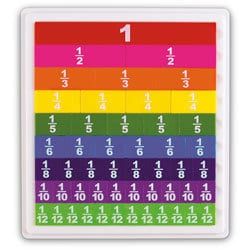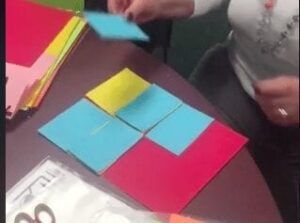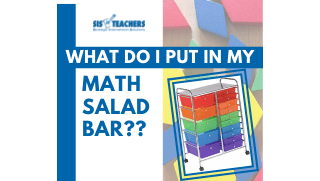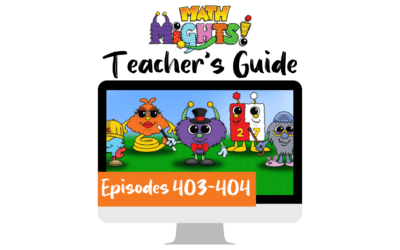We’re finishing up February, and concluding this series of math games for Math with Someone, with a fractions game!
 Cover/Uncover is a simple fraction game that can be easily differentiated in your classroom and uses some great fraction tools – fraction tiles and area model papers. For more on other types of fraction manipulatives, check out our videos on getting fraction manipulatives student-ready and this blog series on fractions.
Cover/Uncover is a simple fraction game that can be easily differentiated in your classroom and uses some great fraction tools – fraction tiles and area model papers. For more on other types of fraction manipulatives, check out our videos on getting fraction manipulatives student-ready and this blog series on fractions.
When students are using fraction tiles to find equivalent fractions, they often try to use the “guess and check” method. If presented with two ⅓ pieces and asked to find an equivalent fraction, they might start with the 1/10 and see how many of those would fit. Finding it to be uneven at the end, they’ll grab another set of pieces and keep trying until they find the equivalent. However, we want students to be more confident and strategic in identifying equivalent fractions, so a game like Cover/Uncover is great practice.
A note about fraction tiles: Fraction tiles might not be my favorite fraction tool because each tile is stamped with the fractional part, which makes them always predictable. They don’t allow students to use any kind of conceptual thinking about the size or the proportions of the pieces. However, I do think that, for students in 2nd, 3rd, 4th, and 5th grade that are new to fractions, that it’s important to present the fraction tiles as a useful tool.
Cover/Uncover
Materials:
 Fraction manipulatives:
Fraction manipulatives:
- Fraction Tile Kit (1 per player). Recommended for younger students or those newer to fractions who are just starting to become familiar with the whole and how it is broken up to make different parts. Normally, we say that you only need 15 sets of fraction tiles in a Math Salad Bar because you typically have students use them in pairs. However, if you’re going to teach the game to your entire class, you might need to go to the teacher next door and borrow their sets so every student has one. If this isn’t an option, just have small groups of students at a time watch the video and learn how to play.
 Area Model Papers (1 set per player). Recommended for older students or those more familiar with fractions. These are not stamped with fractional parts, but are simply card stock cut into halves, 4ths, 8ths, 16ths. They are great for helping students conceptualize the whole. Download the template for creating these manipulatives on our website and watch the video about how to get them student ready!
Area Model Papers (1 set per player). Recommended for older students or those more familiar with fractions. These are not stamped with fractional parts, but are simply card stock cut into halves, 4ths, 8ths, 16ths. They are great for helping students conceptualize the whole. Download the template for creating these manipulatives on our website and watch the video about how to get them student ready!
- Fraction die. I’ve noticed that I can never find one with the right fractional parts I need, so the easiest thing to do is make your own! I get a 1” cube and just write on it with a Sharpie! There are also dice that come with stickers or even dry erase dice.
- If using fraction tiles, mark the faces ½, ¼, ⅛, ⅛, 1/12, 1/12
- If using area model papers, mark the faces ½, ¼, ⅛, ⅛, 1/16, 1/16
- A Partner
Level 1: Cover Up
This introductory level is great for younger students, such as those in 3rd grade or just starting fractions. It could also be an introductory or review game in 4th or 5th grade.
Rules:
- Take turns rolling the fraction die.
- On your turn, the fraction that comes up on the die tells what size piece to place on the whole strip.
- Check with your partner to be sure he or she agrees with what you did.
- After finishing your turn, say “Done” and pass the die to your partner .
- The first player to cover up their whole exactly wins.
- Important Note: If you need only a small piece- 1/8 or 1/12, for example- you can’t play. You must roll a fraction smaller than or exactly what you need.
There’s not a lot of strategy going on in this level apart from students getting the idea of the parts of the whole. You’ll see kids will be “guessing and checking” to see if that piece they rolled will or will not fit. But they’re using friendly fractions because they’re all in the even pattern with using ½, ¼, ⅛, 1/12.
You could make the game more challenging by using different manipulatives, like the area model papers, that have different fractional parts.
Level 2: Uncover 1
Uncover uses the same materials and the same basic rules, except we go the opposite way here – instead of covering the whole with fractions, we’re trying to uncover it by removing fractional parts as they’re rolled.
Rules:
- Each player covers his or her whole strip with the two 1⁄2 pieces.
- Take turns rolling the fraction die.
- On your turn, you can do one of three things:
- Remove a piece only if you have a piece of the size indicated by the fraction facing up on the die. If I roll a ½ and I have ½, I can remove that piece.
- Exchange any of the pieces on your whole strip for equivalent pieces. If I roll a ⅛ and realize that I don’t have an 8ths, I can exchange my ½ for two ¼ pieces or four ⅛ pieces.
- Do nothing. Some kids will do this, hoping they’ll just roll a ½ and ½ and then win right away. As you might guess, this only works if they’re really lucky, especially if their partner is actively trying to get rid of their fractions.
- Check with your partner to be sure he or she agrees with what you did.
- After finishing your turn, say “Done” and pass the die to your partner.
- The first player who removes all pieces from the whole strip wins.
Important Notes:
● You may not remove a piece and exchange on the same turn; you can do only one or the other.
● You have to go out exactly. That means if you have only one piece left and roll a fraction that’s larger, you may not remove the piece.
Level 3: Uncover Version 2
In this version, we use the same materials and the same basic rules, but we bring in equivalent fractions!
Rules:
- Each player covers his or her whole strip with the two 1⁄2 pieces.
- Take turns rolling the fraction die.
- On your turn, you can do one of three things:
- Remove one or more pieces from your board as long as they add up to the fraction facing up on the die. If I rolled ½, I could obviously grab the ½, but later, if I were to roll ⅛ and I happened to have 2/16, I could pull those off. If I rolled ¼ in my fraction tiles, I could pull off 2/8.
- Exchange any of the pieces on your whole strip for equivalent pieces.
- Do nothing.
- Check with your partner to be sure he or she agrees with what you did.
- After finishing your turn, say “Done” and pass the die to your partner.
The first player who removes all pieces from the whole strip wins.
Option B is where students have to really think about what they’re doing. You want them to be more strategic in how they’re replacing their blocks. I could take my ½ and exchange it for 2/4, 4/8, or 6/12 (if I were using the fraction tiles – adjust fractional parts if using area model papers). I might want to do a combination of ¼ and 2/8. Kids will start to realize that there is more of a probability of rolling the ⅛ or 1/12 than the ½ or ¼. Because of this, do they go for more 8ths if they know they can always remove 2/8 if they roll a ¼? Of course, you want kids to pick up these strategies on their own (don’t tell them!) and start to have these realization of how to play better.
At the end of their turn, you want the students to check and see if their partner agrees with the way they’ve done it. When they’re done with the way they’re doing it, they say done and pass the die to their partner. The first player that removes all thier pieces from the whole strip wins.
To add complexity to Levels 2 and 3, you can start by playing with the fraction tiles, and then move to the area model papers as students start to think about other equivalents that they could pull off or they could exchange.
Accountability
An accountability sheet is very easy for this game. You would want students to record what they rolled and show the equivalent fractions. It could be just a half-sheet of paper that they turn in so you can see that they’ve been working through that process as they’re doing it.
Next week, we’re going to start working on fractions and looking at some video tutorials that can help you in your classroom as you teach all the operations with fractions and knowing which manipulatives you can use!



